The Dell XPS 13 (9300) Review: Return of the King
by Brett Howse on July 16, 2020 10:00 AM ESTSystem Performance
When we reviewed the XPS 13 2-in-1 back in November, it was the first device we had tested which featured the new 10 nm Intel Ice Lake platform. At that time, Dell had also recently refreshed the XPS 13, but had outfitted it with the older 14 nm Comet Lake platform. For the all-new XPS 13, Dell has now brought parity to their lineup with Ice Lake here as well, with the improvements that platform brings, especially to the graphics side.
Dell offers three processor options. The least-expensive offering is the Core i3-1005G1, the mid-tier outfitted with the Core i5-1035G1, and the top-tier offering the Core i7-1065G7. Our review unit features the Core i7 model, as Dell wanted to put its best foot forward.
On the memory side, Dell’s spec sheet shows a 4 GB base, although thankfully that is nowhere to be found on their Dell.com site, at least for the USA. Thanks to the move to LPDDR4X with Ice Lake, Dell now offers up to 32 GB of memory on the XPS 13. Storage is all PCIe x4 NVMe, with 256 GB as the base, and a 2 TB maximum.
To see how the XPS 13 performs, we have run it through our newly updated laptop suite. Please not that if a graph does not contain a specific older device, that means that the test has not been run on it. Since the laptops are returned to the manufacturer after review, we cannot do any regression testing for the most part. If you’d like to compare the XPS 13 to any other laptop we have tested, please refer to our Online Bench.
PCMark
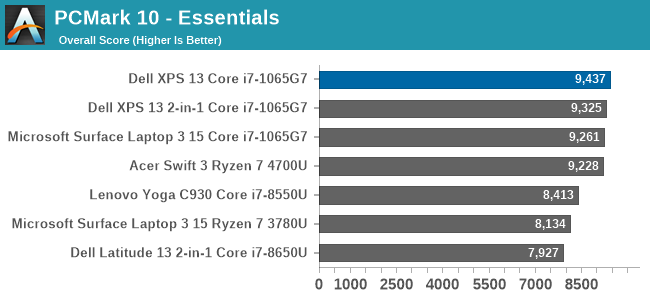
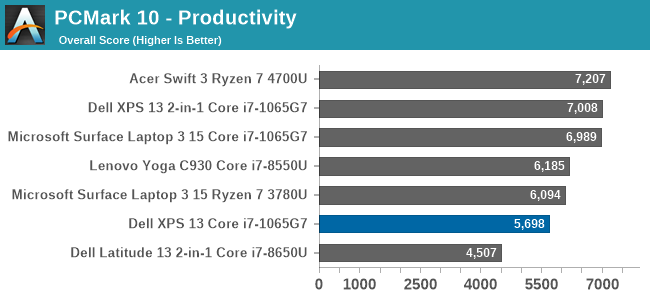
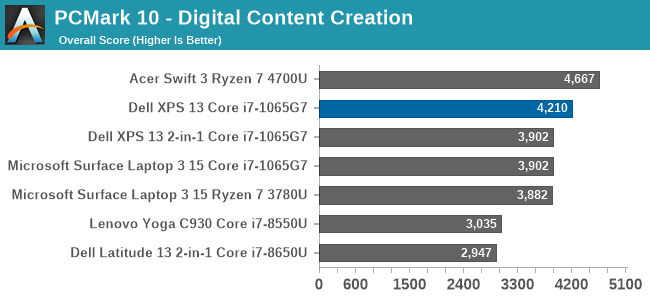
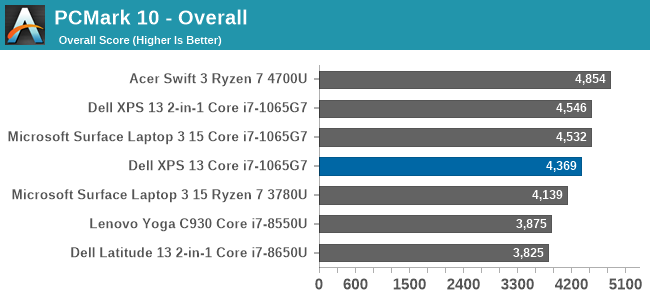
UL’s PCMark 10 is a whole-system benchmark, testing everything from CPU performance to app loading time. The Overall score consists of three categories, each featuring their own unique sub-tests. Overall the XPS 13 scored right in the same ballpark as other Ice Lake notebooks, although was slightly down in the Productivity tests, but slightly ahead in the other two.
Cinebench
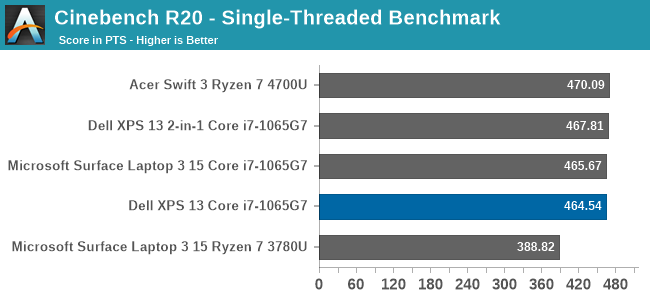
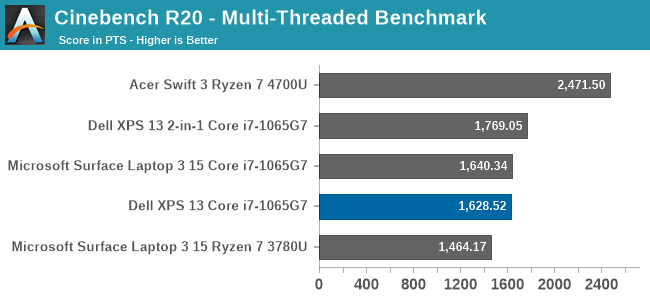
Cinebench, based on Maxon’s Cinema 4D rendering, allows tests of both single-threaded and multi-threaded runs, making it one of the more popular tests for overall computational performance. The XPS 13 does well compared to other Ice Lake equipped notebooks, although with AMD offering up to 8 cores in the same 15-Watt TDP, Intel falls behind in the multi-threaded run.
Handbrake
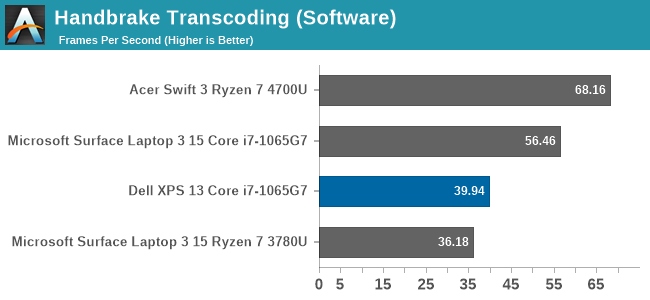
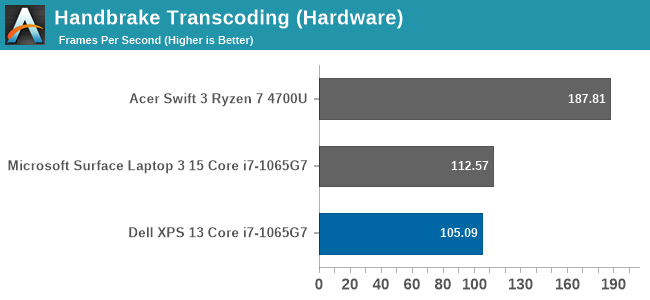
In our Handbrake encoding test, we transcode a 1080p movie to 720p using both software and hardware encoders. Software encoders utilize the CPU, and are generally the preferred method for optimal quality, whereas hardware encoders leverage the media blocks, which in this case is Intel’s QuickSync, for a much faster encode. As we will see more in the thermals section, Dell limits the XPS 13 to a 15-Watt TDP even in its maximum performance mode, where some other manufacturers will allow for higher than listed TDP, up to 20 Watts or so, and as such, the XPS 13 falls a bit behind other Ice Lake notebooks in this test which is TDP limited.
7-Zip


The popular file compression and decompression tool 7-Zip includes a built-in benchmark, and once again the XPS 13 slots right into where other Ice Lake notebooks fit.
Web Tests
Web performance is a function of not only the CPU performance, but also the browser’s scripting engine, and as such we have standardized on the Microsoft Edge browser. Microsoft has now transitioned their browser to the open-source Chromium project. Due to this, we have reset our web tests to use the new Chromium based Edge and taken the opportunity to decommission some of the older tests. We will now focus on Speedometer 2.0 and WebXPRT 3.
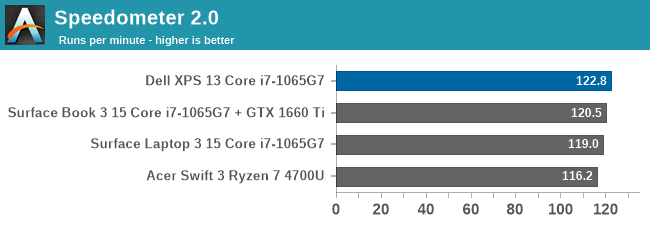
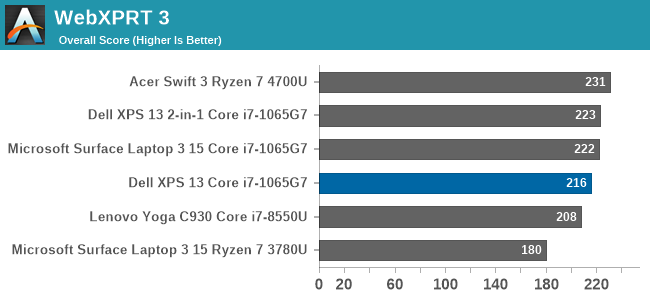
The XPS 13 again slots right in where you would expect for an i7-1065G7 based system.
Storage Performance
Dell offers from 256 GB to 2 TB of PCIe storage, and the review unit was outfitted with the Intel 600p 512 GB drive. We are transitioning to the PCMark 10 storage benchmark, which uses test traces of actual common workloads, such as booting Windows, and many of the Adobe applications, and as such should be a much better indicator of drive performance than just maximum transfer rates.
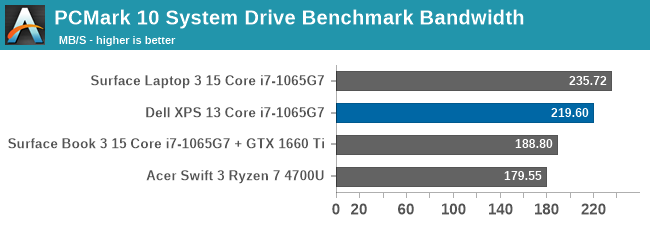
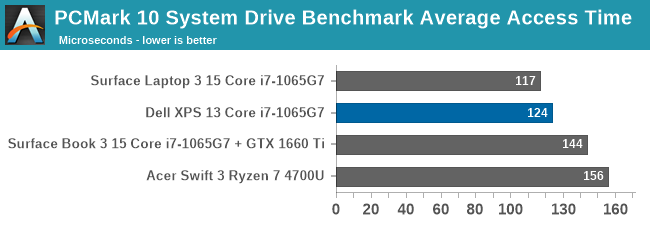

The Intel 600p performs quite well, with good access times and solid bandwidth. Surprisingly, it can’t quite match the excellent performance we saw from the SK Hynix 2230 form factor SSD in the Surface Laptop 3, but almost matches it.











224 Comments
View All Comments
Gigaplex - Sunday, July 19, 2020 - link
I'm a programmer, but I rarely use the laptop keyboard. I plug it into a dock and use a desktop keyboard.TEAMSWITCHER - Sunday, July 19, 2020 - link
So .. you agree with me?mjz_5 - Friday, July 17, 2020 - link
I hope they fixed the Bluetooth. I can’t move three feet away when trying to listen to music on my 2016 XPS 13”. Same headphone on my iPhone, I can go all over the house.Tunnah - Friday, July 17, 2020 - link
I used to say "unless it's Intel I'm not gonna bother", am now just realising with the latest AMD mobile chipsets, I've firmly swung in the other direction. It feels almost daft to go with Intel nowadays considering what AMD are putting out. I'd love one of these with new Ryzen in itisthisavailable - Friday, July 17, 2020 - link
This "king" is overrated. Surface Laptop is miles better at a lower price. The i3 and i5 versions of xps are useless because they are G1. 4gb ram version is, again, useless. It's not even a $1000 laptop.hanselltc - Friday, July 17, 2020 - link
The lack of Ryzen here means there are sub 600 dollar laptops running laps around this when any resemblance of stress is present. Makes this a lot less attractive.Deders - Friday, July 17, 2020 - link
Not sure why people still say windows 10 still handles HDR poorly, have they tried it since the HDR update? Apps look fine to me, everything looks fantastic (if a little bright)trenzterra - Friday, July 17, 2020 - link
I had the XPS 9300 for a couple months before deciding to sell it. There are some issues with this laptop which wasn't highlighted in this review:- The display is really bright and all, but I had issues with screen colour uniformity -- on my set, there were two vertical "bars" where the colour had a little bit of green tint to it, noticeable on white or grey backgrounds. I had my display replaced twice before getting a decent one. After the lockdown was lifted, I went to look at display units in shops and it appears many of the Full HD and 4K sets had the same issue. Perhaps it's my eyes, or maybe panel lottery is particularly bad on this laptop.
- For some reason, my microSD card kept getting stuck in the slot (slot seemed misaligned or something, causing the spring mechanism to get stuck). In the end, I had to get a replacement laptop from Dell.
- The current firmware, 1.0.11 (and the previous, 1.0.10), has issues outputting video with certain USB-C to HDMI adapters. This has been going on for two months with no fix in sight, despite bringing it up to Dell's attention: https://www.dell.com/community/XPS/XPS-13-9300-BIO... . Further, users are also reporting issues connecting to certain LG and Samsung USB-C/ TB3 monitors (issue reported at launch but no fix yet -- apparently, you need to plug a separate power cable into the laptop and then plug the LG/ Samsung monitor into the other port just to get it to work, notwithstanding that the Samsung/ LG monitors are supposed to do PD passthrough). TB3/ PD support is really buggy on the XPS 9300 at the moment, and I wonder if they will ever get it fixed.
- If you have the Fast Startup option disabled (which is essentially hibernation in a different form), or restart the laptop, the laptop takes about 1min to startup, even on a whooping fast SSD. No fix in sight despite a 10-page+ long thread on the Dell forums: https://www.dell.com/community/XPS/Bug-New-XPS-13-...
- The laptop gets hot very easily at the palmrest area. I think this is a byproduct of the carbon fibre palmrest which kinda traps heat.
Overall, I found the laptop to be of rather good build quality and very good to look at. However, the flaws and lack of after-sales support (in terms of fixing BIOS/ firmware issues) from Dell has left me somewhat disappointed and I decided to cut my losses and sold it. Now I'm holding out for Renoir options...
trenzterra - Friday, July 17, 2020 - link
To clarify on the boot times, the laptop gets stuck on the Dell "loading" logo for about 40 seconds, even on a fresh install without bloatware. It seems like a BIOS bug (where something is being stuck) more than anything else, but since Fast Startup is left enabled by default (I prefer to disable it to reduce unnecessary writes to the SSD), Dell doesn't seem keen to fix it.Spunjji - Monday, July 20, 2020 - link
These issues remind me of most of Dell's high-end releases since at least 2008. Shame :/